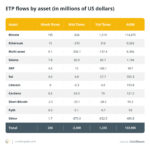On Tuesday, a wave of turbulence swept through the cryptocurrency market, with multiple tokens experiencing staggering declines of up to 50% in a matter of minutes on the Binance exchange. Observers are now examining whether the culprit behind this dramatic downturn could be a misconfigured trading bot that triggered a frenzy of selling activity. Among the most affected tokens were Act I, the Prophecy (ACT), which plummeted by 50%, and DeXe (DEXE) and dForce (DF), which saw drops of 30% and nearly 20%, respectively, around 11:00 UTC, with no immediate explanation for the sharp declines.
Other tokens, including HIPPO, BANANA31, TST, and LUMIA, also faced similar but less severe decreases shortly after the same time. Interestingly, some traders acted quickly to snap up dips in tokens like KAVA, indicating a mix of panic and opportunity in the market. Notably, the affected tokens appear to be unrelated and come from various sectors, making the situation all the more perplexing. Data indicates a significant spike in selling volume around the same time, but most other cryptocurrencies on Binance did not exhibit comparable spikes.
The groundwork for this volatility may have been laid just half an hour earlier, when Binance announced changes to leverage requirements and margin tiers for several perpetual contracts, including ACT/USDT. These new rules apply to existing positions, likely prompting trading bots and algorithms to adjust their positions, which caused a ripple effect that impacted spot prices.
This sharp decline didn’t just stay contained to Binance; the price drops echoed across other centralized and decentralized exchanges, as tokens mirrored the falls experienced on Binance. Early reactions on the social media platform X ranged from disbelief to speculation that an erroneous market-making bot was the driving force behind the sudden sell-off. According to Andrei Grachev, founder of DWF Labs, the sheer breadth of the declines among unrelated assets suggests something unusual may have occurred, saying, “Seems someone has been hacked or banned or idk.”
Market participants have pointed out that while the update primarily affected perpetual contracts, the implications spilled over into spot markets as traders using cross-margin setups or running arbitrage strategies were forced to reevaluate their positions. A varying mix of both algorithmic and discretionary traders appeared to exit the markets to mitigate their risk in response to this sudden turn of events, showing how interconnected and volatile the crypto space can be in times of rapid change.

Crypto Market Volatility on Binance
Recent events on the Binance exchange caused significant declines in multiple tokens, raising concerns and speculations about the underlying causes.
- Significant Price Drops:
- Act I, the Prophecy (ACT) fell by 50%.
- DeXe (DEXE) experienced a 30% drop.
- dForce (DF) declined nearly 20% within minutes.
- Other tokens like HIPPO, BANANA31, TST, and LUMIA saw similar, albeit smaller, declines.
- Potential Causes:
- A surge in selling volumes occurred at 1100 UTC, coinciding with price drops.
- Binance announced changes in leverage requirements and margin tiers at 10:30 UTC, potentially triggering trading bot adjustments.
- Market speculation suggests a misconfigured trading bot may have contributed to the sudden declines.
- Market Reactions:
- Traders expressed surprise and confusion on social media platforms.
- Panic selling ensued, leading to further price declines across various exchanges.
- Market participants were forced to adjust positions, leading to additional volatility.
“Seems someone has been hacked or banned or idk,” noted Andrei Grachev, indicating a lack of clarity around the situation.
These developments highlight the volatile nature of cryptocurrency trading and the impact of automated trading systems on market behavior. Users should be aware of how market structure changes can lead to unexpected outcomes and ensure they are prepared for sudden market shifts.
Market Turmoil on Binance: Analyzing the Fallout from Rapid Token Declines
In an unexpected turn of events on Binance, a significant market downturn saw several tokens plummet by up to 50% in a matter of minutes. Such volatility has brought to light questions regarding the potential role of misconfigured trading bots in precipitating these sharp declines. Tokens like Act I, the Prophecy (ACT) and DeXe (DEXE) witnessed staggering losses, stirring a mix of confusion and concern among traders and market observers.
One competitive advantage this news presents to Binance is the attention it draws to the platform’s trading ecosystem. However, it also opens the door for criticism, with traders potentially losing confidence in the exchange’s operational integrity, especially after the correlations observed in token performances across unrelated assets. The initial panic was exacerbated by an announcement regarding changes in leverage requirements and margin tiers just before the market’s tumble, highlighting the potential vulnerabilities of rapidly changing trading conditions.
For traders utilizing strategies in perpetual contracts, the fallout could be twofold. On one hand, immediate alertness is essential for mitigating losses, particularly for those employing cross-margin setups. On the other hand, savvy traders who thrive in volatile conditions might find opportunities amid the chaos. The ability to buy dips following a sell-off may serve as a short-term benefit for these individuals, contrasting sharply with those who are more risk-averse or uninformed about market mechanics.
The market also faces challenges from rippling effects across other exchanges, where the same tokens experienced correlated declines, suggesting a broader concern surrounding overall market sensitivity to sudden announcements or bot trading behavior. This cascade impacts not just individual traders but potentially creates a hesitant sentiment within the market, prioritizing risk management over speculative trading.
In essence, while this incident may benefit agile traders accustomed to navigating market shocks, it poses significant hurdles for less experienced participants or those who depend on stable market trends to strategize their investments. The call for regulatory considerations on trading bots and transparency in exchanges is likely to resonate louder in the aftermath of this turmoil, indicating a need for increased scrutiny and protective measures in the crypto trading environment.

















